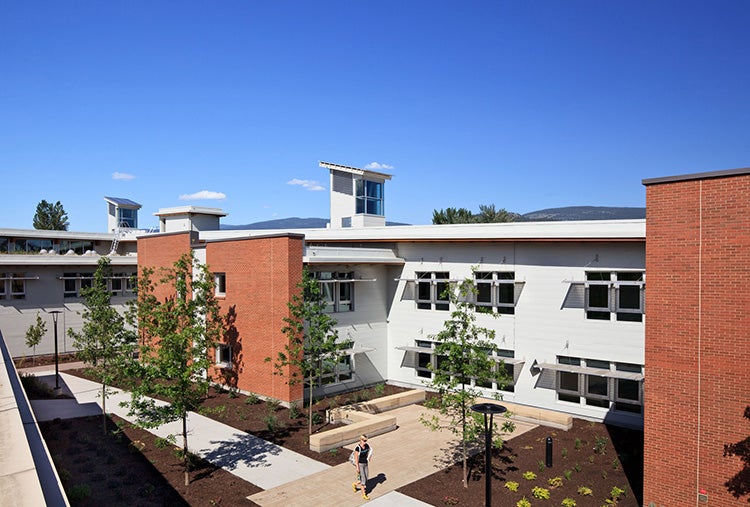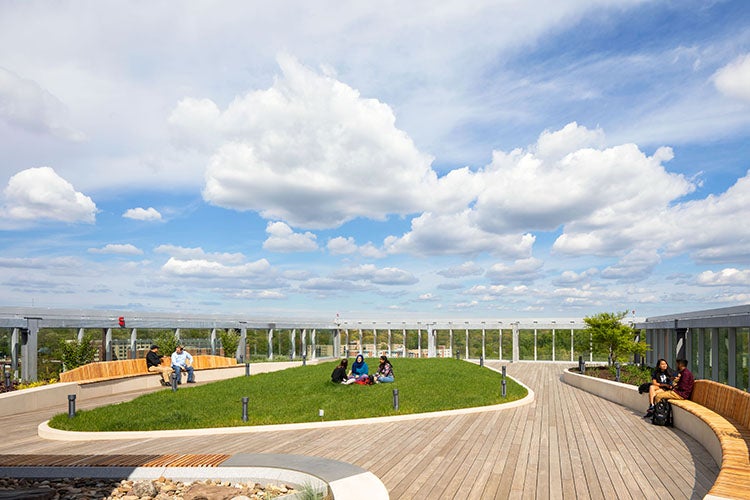
5 Essential Roles for Landscape in Campus Design
It’s that time of year again. Many students across the U.S. and Canada are headed back to school — some stepping on college campuses for the first time. The images that populate our television screens and electronic devices are familiar: groups of backpack laden students make their way through the central quad, sprawl books and computers on campus lawns, and stop and mingle on the mall. But images can be deceiving. While landscapes often evoke this type of campus imagery, they also have many functional roles to play in campus planning, several of which are evolving as academia adapts to shifting societal norms and environmental imperatives. In this post, I’ll explore five essential roles that landscape can play on today’s campus.

1. Landscape as Sustainability Catalyst
Back when LEED was new, universities were able to get a lot of prestige from achieving LEED certification. Today, it is less the exception, more the norm, and many institutions are realizing they have to move beyond systems that focus on simply doing less harm. More and more universities are prioritizing net zero and regenerative campus design goals. Perhaps not surprisingly, landscapes are perfect candidates for supporting these environmental initiatives. To meet the moment, we are dusting off some of the old “passive” design techniques from the 70s and considering things like shelter belts and tree canopy shading that have a lot to contribute to net zero approaches.
Many traditional landscape elements are extremely functional from an environmental perspective. Healthy plants and soil are one of the most effective and cost efficient ways of sequestering carbon. However, not all plants are created equal which calls into question some traditional campus features, such as large areas of lawn. Critical analysis is required to find the right balance of usability with performance. Landscapes serve an important function in attracting prospective students and their parents, but we also need to think about how to get multiple layers of functionality out of campus open space. Sports fields can reduce storm water runoff. Sites can be designed to get maximum use of limited hardscape and protect and restore native vegetation. Just because a landscape is historic or iconic, doesn’t mean it cannot support sustainable features. University of Chicago’s main quad — which removed vehicular traffic and installed large areas of permeable paving — is one example of this.

2. Landscape as Wellness Driver
Similarly, wellness is a hot topic and key priority on many campuses right now. Much of this is a response to the staggering numbers of students who, according to the American College Health Association, report that anxiety (27.8%), depression (20%), sleep difficulties (22.4%), and stress (34.2%) have affected their academic performance in the last year. Here again, landscapes are the perfect candidate to support these efforts. Nature has inherent benefits for supporting the physiological and psychological needs of students and staff. Integrating landscape and building design more holistically can reveal inventive opportunities to provide respite and environment for interaction away from technology on campus.
Living on campus is an important aspect of students’ social development, and we are getting smarter about supporting this development in the design of residence halls and other student life facilities. But it’s important for the outdoor environment to also be part of this conversation. For example, many campuses have a plethora of large open spaces, which support particular types of interaction. However, smaller spaces that are more conducive to supporting smaller groups of people and creating more intimate settings are often missing. One successful example of a smaller scale outdoor space on campus is the rooftop park on top of the new Brendan Iribe Center for Computer Science and Engineering which offers stunning views of campus with space to sit, walk, study and mingle with friends, but in a relatively quiet setting.

3. Landscape as Technology Integrator
Although there are plenty of ways to create “technology-free” zones on campus, the reality is that most landscapes today are inherently “technology rich” and this will continue to increase with new developments and innovations. The way we use space is impacted by a changing technological environment. I was reminded of this recently when I accidently almost collided with three Pokémon Go players while I was riding on a local bike trail. The emergence of augmented reality games like Pokémon Go is just one example of how suddenly the impact of technology can be felt by propelling a whole new type of site user into the world. These users have different behaviors and needs that may sometimes be in conflict with more traditional users. Similarly, the widespread adoption of mobile technology on campuses has made almost any open space a place to study or collaborate.
And beyond personal devices — technology is changing the world of transportation. We have already seen the extensive impact of ride-sharing and bike-sharing which is changing how people use streets. Cities and campuses are considering “curb management” strategies and thinking about whether drop off zones are sized correctly for today’s needs. Autonomous vehicles are set to change this relatively new pattern again in a few years, and will start to impact the amount of real estate we devote to parking.
It’s clear that technology is driving an entirely new set of uses in the campus landscape — and these must be accounted for in campus design efforts.
4. Landscape as Data Source
Increased use of technology goes hand-in-hand with the increased access to more and, at times, real-time data. Academic institutions have been evolving their own approach to institutional data over the last decade and embedding it into their decision-making processes. At HDR, our campus master planning efforts regularly employ institutional data and our data-driven design team has created specific tools that allow us and our clients to visualize data in 3D or drill down into detailed information during the planning process. This type of tool can be used to assist in facilities operations and management too. Data can be used to help facilitate parking management, security, event management and provide dynamic wayfinding to give just a few examples.
While it is an emerging trend, landscape maintenance is no exception. For example, at Michigan State University, the Infrastructure Planning and Facilities Department has streamlined their landscape services by using GIS technology to create more efficient, data-driven operations, allowing landscape teams to record and see a map of their work in real time. This level of access and transparency creates higher productivity and a more collaborative culture, where everyone can see how they are contributing to overall goals.
This results-driven approach is starting to take hold in the larger industry as well. For example, SITES, a sustainability-focused framework that ushers landscape architects, engineers and others toward sustainability, focuses on performance measures rather than prescribing practices. The ability to effectively track activity, maintenance costs, energy usage and more will only grow in importance as more campus design efforts fully leverage the capabilities and insights provided by data analytics.
5. Landscape as Network Mortar
Landscapes have always been the “glue”— critical to connecting places on campus. But just as the nature of what constitutes a “traditional” student is no longer as clear as it once was, what constitutes a “traditional” campus has also changed in recent years. Technology, online courses, lifelong learning, industry partnerships and a shift towards problem-based curricula have blurred the lines between city and campus. Campuses are more decentralized than ever before. Students can learn anytime, anywhere — creating a vast educational environment that can at times be a challenge to navigate.
The landscape plays a key role in connecting these disparate places to one another. Interstitial spaces offer many opportunities whether that be through town-gown strategies for sharing community resources, stimulating development or embracing “pop-up,” entrepreneurial culture.
As the dynamic nature of the above trends indicate, the human relationship to landscape is ever-changing. The ways in which we can use landscape to promote environmental stewardship, student and faculty wellness, and better learning outcomes are always evolving. This pace of change in academia is simultaneously challenging and exciting from a campus design and planning perspective. Integrated planning efforts need to pull together multiple stakeholders, consider the interconnectedness of different built and natural environments, and take a holistic view of the campus. Landscape should always be (and most often is) a key aspect of that effort.




